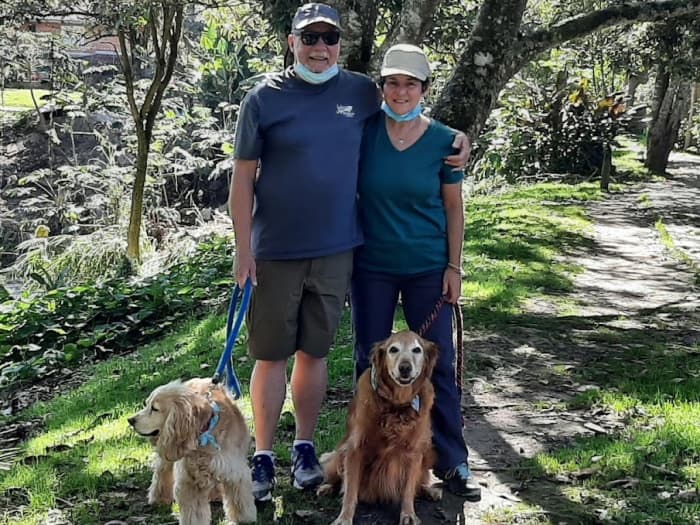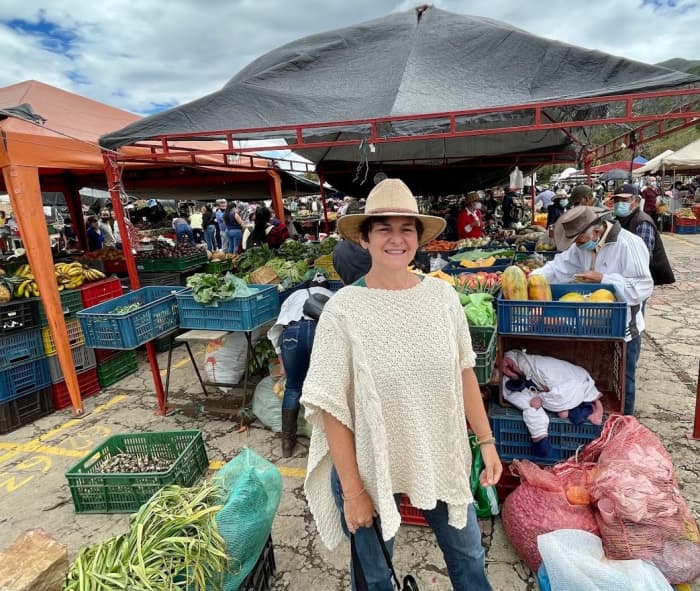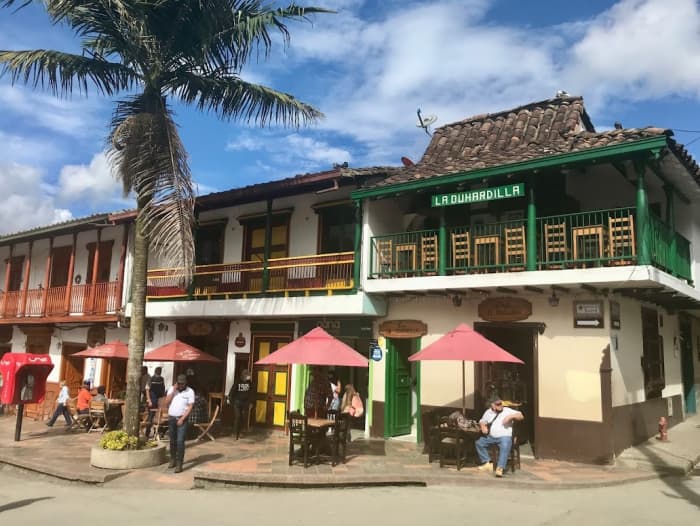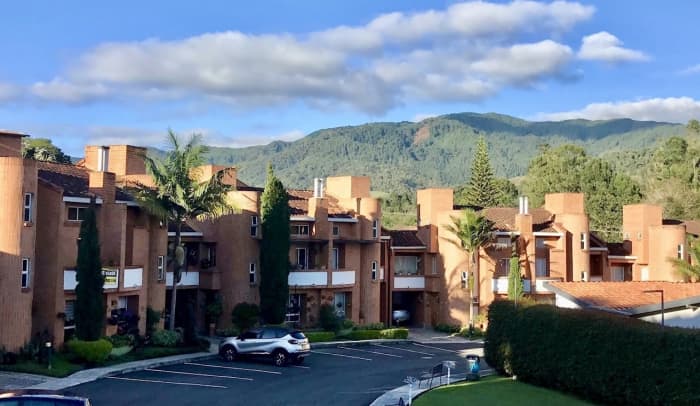This couple retired in Colombia on $4,000 a month. In California, ‘to live this lifestyle, we’d have to be mega, mega millionaires’
This adventure-seeking couple has lived in Panama, Colombia, and is eyeing Spain in a few years

John and Susan Pazera are unusual expats: they seem to move just about every three years.
They’ve lived in Boquete, Panama, then Medellín, the second-largest city in Colombia and once known for Pablo Escobar and drug cartels. When COVID made all the things they love about a city unavailable, they decided to move to El Retiro, a smaller, quieter town about 45 minutes away. They’re already talking about moving to Spain to better explore Europe and Africa in several years, once they no longer have dogs. And that probably won’t be the last place.
“We’re healthy, we have a lot of energy, and there’s a lot of places we still want to see,” said John, who is 66 years old. Susan is 62.
Their wanderlust dates back more than two decades, when they bought a 42-foot sailboat, sold everything that wouldn’t fit on the boat, lived on it for three years while working in San Francisco, and finally “cruised” the Pacific Ocean and the Caribbean for three years.
Panama was one of the stops, and they knew then that they wanted to return. In 2015, after John retired from a job in the wholesale wine and spirits industry at 59, the pair moved to Boquete, in the mountains of Panama. Susan continued to work remotely until she retired in June 2021.
The couple travels light compared with some expats they’ve seen arrive in Boquete with a container full of belongings; they moved with eight suitcases, one of which was filled with gear for their two dogs, a 12-year-old golden retriever named Rosie, and Tango, their 14-year-old cocker spaniel.
Boquete attracts foreign retirees; its expat community is estimated between 3,500 and 5,000 people. That made the transition to living outside the U.S. relatively easy, they said. They didn’t need to speak much Spanish to feel comfortable and could continue using the U.S. dollar, rather than dealing with exchange-rate fluctuations. They even bought a home.
“For us it was a good launching pad to becoming expats,” Susan said.
Another move
But after three years, they decided it was time to move on. “We got restless, we wanted to improve our Spanish and have more of a connection to the community. We wanted to be more challenged,” said Susan.
When they visited friends from Boquete who had moved to Medellín, they decided this was their next home.
The cost of living is lower, and medical care is better than in Boquete, they’ve discovered. So is both the infrastructure and the weather. They rarely have power outages, can drink water from the tap and aren’t getting the deluges of rain that Boquete experiences in its seven-month-long wet season.
When they want to visit family in the U.S., it’s easier and cheaper to get a flight.

Susan Pazera in a market in eastern Colombia.
JOHN PAZERA
Colombia, and Medellín in particular, have come a long way since the days of fighting involving guerrilla movements, paramilitary groups and the government as well as Pablo Escobar and the cocaine drug cartels that made Medellín, and particularly the Comuna 13 neighborhood, so dangerous. While there are still bad neighborhoods in Medellín, the city is now a big tech hub for South America. And this past August, the Pazeras traveled in eastern Colombia on their own, something they say wouldn’t have been safe 20 years ago.
Like with many others, though, COVID-19 made the Pazeras reconsider where they live. During Colombia’s strict lockdown, the city amenities they loved were suddenly no longer available. And they found they enjoyed the silence and cleaner air that the restrictions brought.

The main square in El Retiro, Colombia
SUSAN PAZERA
Now in El Retiro, a town of about 21,000 people 45 minutes from Medellín, the couple says they feel more immersed in Colombia than they did in the larger city. They live about four blocks from the town’s main square and spend their time studying Spanish, meeting friends and blogging about their life. They’ve bought a car and started traveling again; their goal is to visit every country in South America before they leave Colombia.
“We live a very comfortable middle-class lifestyle” for $4,000 a month, excluding travel, Susan said, while acknowledging it’s possible to live on a smaller budget. In California, where they had lived, “to live this lifestyle, we’d have to be mega, mega millionaires.”
Here’s how they do it:
Housing and other costs

The community in El Retiro where the Pazeras live.
SUSAN PAZERA
The Pazeras rent a 2,150-square foot three-story, three-bedroom townhouse with a backyard for about $900 a month. They paid about the same in Medellín for a 1,775-square-foot apartment.
Among their other costs, utilities — electricity, water and trash — is $67 a month. In Long Beach, Calif., their last U.S. address, it was about $200, and in Boquete electricity alone was about $60.
Internet, phone and cable TV costs $25 a month in El Retiro; it’s $76 in Boquete. Their monthly cellphone data package is $36 with about twice the amount data that their $45 package in Boquete included.
A set-menu lunch for two at a local “typico” restaurant in El Retiro costs $7 or $8, and the bill at their local steak restaurant is $20 to $25 with a bottle of wine. Dinner for two at an upscale restaurant is $50, half that of Boquete. In California, it would have been at least $150. But the price of wine and liquor is much higher in Colombia than in Panama.
A gallon of gasoline in mid-October 2021 was $2.46, compared with $3.46 in Boquete and, using data from Gasbuddy.com, $3.35 in the U.S. ($4.55 in California).
Healthcare
In Colombia, the Pazeras are required to pay into the national insurance program; it costs them $116 a month and covers both of them. (Pricing is on a sliding scale.) They haven’t had to pay anything for blood work or dental cleaning, for example, but seeing a specialist can be harder and it wouldn’t cover a private room in a hospital.
So they’ve recently supplemented it with a private policy that gives them all that for $140 a month. They’ve also previously paid some costs out of pocket, such as $35 for a private doctor to come to their home and do a full physical.
Panama doesn’t require expats to buy health insurance, and they say they found out-of-pocket costs there higher. They paid about $183 in Boquete for a medical discount plan and another $447 a month on a policy that covered major medical expenses in Panama as well as overseas, with a $5,000 deductible.
Overall, they say, healthcare in Colombia is better than in Panama, the equipment is more modern, and most doctors speak some English. Private doctors generally speak good English.
Visa
Visitors can stay in Colombia for 180 days on a tourist visa. Those who want to stay can apply for another visa during that time.
John qualifies for a retirement visa that can include Susan. Colombia requires that he show monthly income equal to three times the minimum wage, or about $723 a month, and provide other documents. They’re now getting their second three-year visa and have hired an attorney to handle everything for about $1,058. In Panama, the visa cost $3,100 but is good for life.
Tips for others looking to move abroad
Moving abroad isn’t for everyone, the Pazeras acknowledged. The pace of life in Latin America is different. “Things eventually get done,” said Susan. “It just may not be in the time frame you’re used to in the States,”
They’ve seen many unhappy expats go home. Some miss the grandchildren, some are Type A personalities and can’t adjust.
“It’s not all rainbows and sunshine here,” said Susan. “It can be challenging.”
Their advice: Be open to a big change in your lifestyle and be looking for a new adventure. Then reach out to bloggers in the country; they’ll be more upfront about the pros and cons and what to expect. Look on Facebook for groups focused on expats and living in the area. Another possibility is the forums on expat.com.
Finally, “interview” your shortlist. Go to areas where you might live, not to tourist areas. When they considered moving to Medellín, for example, they lived in three neighborhoods over two weeks to find the right fit.
Read more real stories of people who retired abroad

